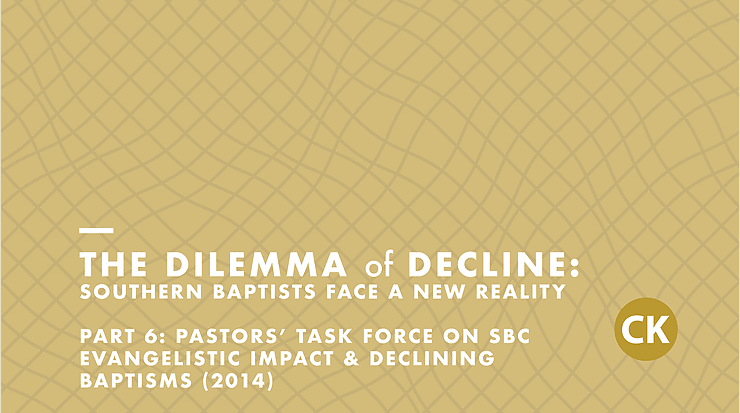By Dr. Chuck Kelley
In 2013, only three years after the GCR proposals were adopted, Al Gilbert, NAMB Vice President for Evangelism, convened a task force of twelve pastors and five denominational workers to take yet another look at the issue of steadily declining baptisms. The group sought to examine carefully the state of evangelism in Southern Baptist churches, to identify whatever problems might be at play, and to ask how those problems could be addressed.
Pastors’ Task Force on SBC Evangelistic Impact and Declining Baptisms (2014)
The group assessed key Great Commission statistics, sharing honestly the evidence indicating the regression of evangelism in the SBC. They found clear indications that SBC churches were experiencing a crisis in making an evangelistic impact on their communities. The task force did not refer to the GCR proposals, the God’s Plan for Sharing initiative, or any other previous approach to SBC decline in their report. Without elaborative details, the Task Force concluded that five problems were driving decline in the Southern Baptist Convention: Southern Baptists had a spiritual problem (need for revival), a leadership problem (need to model evangelism), a discipleship problem (lack of intentionality), a Next Generation problem (failure to reach children and students), and a celebration problem (failure to focus attention).
To address those problems, the Task Force recommended that Southern Baptists pray for spiritual awakening, and that pastors model personal evangelism and provide pathways for their church members to follow their example; that they create a disciple-making culture; that they serve the Next Generation; and that they celebrate evangelism and the baptism event. They made no suggestions on how these steps could be implemented by SBC churches. No potential materials or resources for pastors and churches to use in addressing any of the problems were included with the report or announced for the future. There were no NAMB personnel or programs to help churches follow the recommendations identified and linked to the report. The report was more descriptive than prescriptive. A new strategic plan was not launched.
This approach to the evangelism woes of SBC churches was in stark contrast to NAMB’s emphasis on church planting. While the evangelism network of the SBC was being dismantled, a new network for church planting was being assembled. A strategic plan for finding, equipping, and deploying church planters was developed and implemented, but there was no similar strategic plan for how to rekindle the evangelistic fire in existing SBC churches. Specific numerical goals were set related to finding church planters, enlisting church planting partner churches, and actually starting new churches, but no numerical goals related to evangelism were noted.
The Pastors’ Task Force on SBC Evangelistic Impact and Declining Baptisms was convened in 2013, but it was not mentioned in the NAMB report to the 2014 meeting of the SBC. The report of the task force came between meetings of the SBC, and at the Convention that followed its release, the report was not incorporated into the NAMB presentation to messengers in any significant way. The only reference to the task force heard by messengers at 2015 SBC was this brief statement:
Our Evangelism Group also convened the Pastors’ Task Force on Evangelistic Impact and Declining Baptisms to study the issue of declining baptism rates in the SBC. The task force made several recommendations in its final report (2015 SBC Annual, p. 209).
Clearly, church planting continued to hold the headline for NAMB, while evangelism was increasingly relegated to the small print. Unfortunately, as baptisms continued to decline in the 45,000 churches of the SBC, the annual number of church plants began to decline as well. The new direction for NAMB recommended in the GCR proposals was not producing growth in either church planting or evangelism. A chart of the statistics is coming in Blog 8.
Particularly because of its honesty about the evidence of decline in SBC life, the Pastors’ Task Force report was widely noted at the time of its release in the religious press and social media, generating a spate of articles and blogs about what was wrong with SBC churches. That Southern Baptists would publicly acknowledge that they were in decline was still news. However, the dust quickly settled, and there were few references to the report in the months that followed. The recommendations of the task force were not championed by either the SBC president at the time or the NAMB president, effectively burying the report. Not surprisingly, baptisms continued to decline.
Two consequences of the task force can be noted. Their review of SBC statistics documented the evangelism crisis in Southern Baptist life. Clearly, the North American Mission Board leadership knew that the SBC had an evangelism crisis, that the GCR had not stimulated any change in the downward momentum of baptisms, and that typical Convention churches were struggling to reach people for Christ. Apparently, that knowledge did not warrant any significant adjustments to the strategic plans of NAMB. In fact, according to the organizational chart for NAMB published in the SBC Annuals of 2014, 2015, and 2016, after the Task Force report, the Evangelism Group was first downsized and then eliminated, along with the position of Vice President for Evangelism. On a positive note, the recommendation to celebrate baptisms struck a chord among the churches. Now, making baptisms a celebratory event is often promoted as an occasion for new converts to invite friends and family to church to witness the baptism. They are frequently lost and unchurched people coming to a worship service for the first time. This emphasis has been helpful to churches and continues to expand to this day.
My next blog examines the attempt of a new SBC President to use his power to create another task force to address the decline in evangelism.
Pastor’s Take Away: Announcements are not transformative. Changing the behavior of people requires motivation, instruction, and multiple opportunities for experience. What fresh initiatives with new resources and opportunities for training can you introduce to your church to address evangelism? How can you celebrate any signs of progress?





